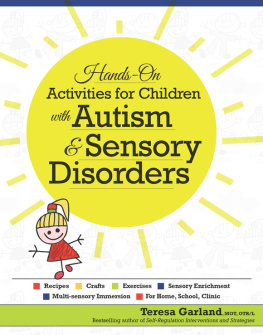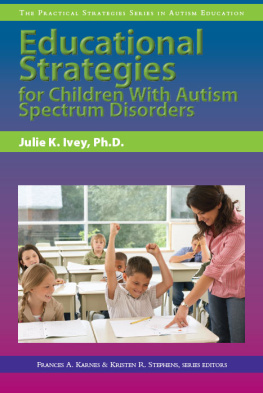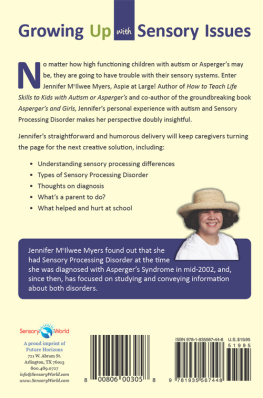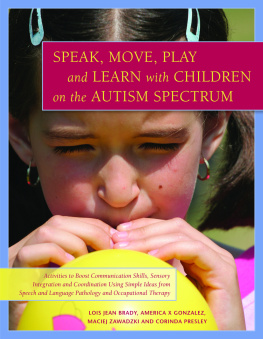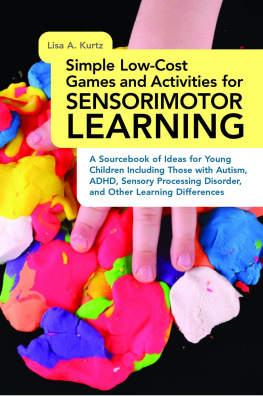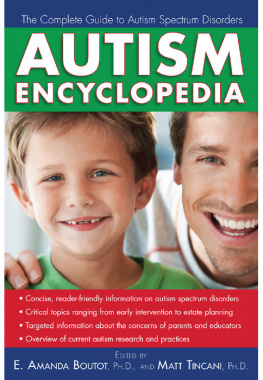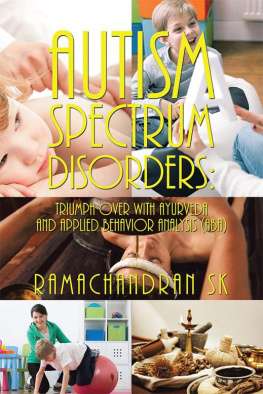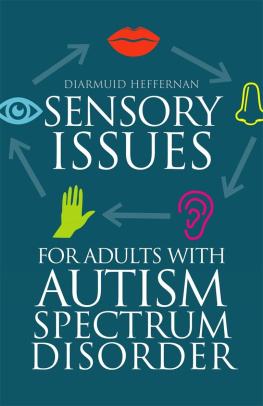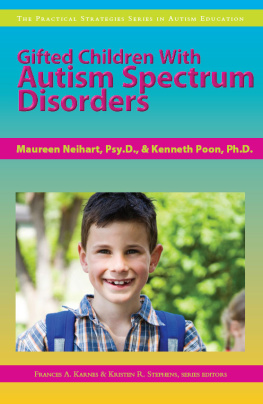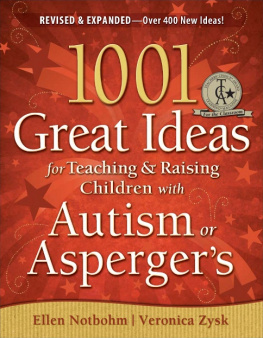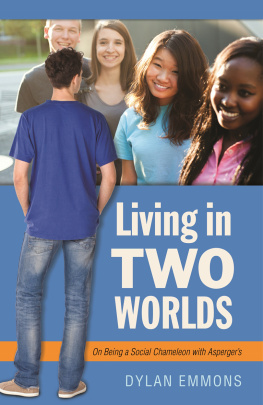Teresa Garland - Hands on Activities for Children With Autism & Sensory Disorders
Here you can read online Teresa Garland - Hands on Activities for Children With Autism & Sensory Disorders full text of the book (entire story) in english for free. Download pdf and epub, get meaning, cover and reviews about this ebook. year: 2016, publisher: PESI Incorporated, genre: Children. Description of the work, (preface) as well as reviews are available. Best literature library LitArk.com created for fans of good reading and offers a wide selection of genres:
Romance novel
Science fiction
Adventure
Detective
Science
History
Home and family
Prose
Art
Politics
Computer
Non-fiction
Religion
Business
Children
Humor
Choose a favorite category and find really read worthwhile books. Enjoy immersion in the world of imagination, feel the emotions of the characters or learn something new for yourself, make an fascinating discovery.
- Book:Hands on Activities for Children With Autism & Sensory Disorders
- Author:
- Publisher:PESI Incorporated
- Genre:
- Year:2016
- Rating:4 / 5
- Favourites:Add to favourites
- Your mark:
- 80
- 1
- 2
- 3
- 4
- 5
Hands on Activities for Children With Autism & Sensory Disorders: summary, description and annotation
We offer to read an annotation, description, summary or preface (depends on what the author of the book "Hands on Activities for Children With Autism & Sensory Disorders" wrote himself). If you haven't found the necessary information about the book — write in the comments, we will try to find it.
Teresa Garland: author's other books
Who wrote Hands on Activities for Children With Autism & Sensory Disorders? Find out the surname, the name of the author of the book and a list of all author's works by series.
Hands on Activities for Children With Autism & Sensory Disorders — read online for free the complete book (whole text) full work
Below is the text of the book, divided by pages. System saving the place of the last page read, allows you to conveniently read the book "Hands on Activities for Children With Autism & Sensory Disorders" online for free, without having to search again every time where you left off. Put a bookmark, and you can go to the page where you finished reading at any time.
Font size:
Interval:
Bookmark:

 Recipes
Recipes  Crafts
Crafts  Exercises
Exercises  Sensory Enrichment
Sensory Enrichment Multisensory Immersion
Multisensory Immersion  For Home, School, Clinic
For Home, School, Clinic
__________________________________________________
Teresa Garland, MOT, OTR/L
Bestselling author of Self-Regulation Interventions and Strategies
Copyright 2016 by Teresa Garland, MOT, OTR/L
Published by
PESI Publishing & Media
PESI, Inc
3839 White Ave
Eau Claire, WI 54703
Cover: Amy Rubenzer
Layout: Bookmasters & Amy Rubenzer
ISBN: 9781559570695
All rights reserved.
Printed in the United States of America.
 | PESI Publishing & Media www.pesipublishing.com |
Acknowledgements

Im grateful to Linda Jackson and her publishing staff at PESIKarsyn Morse, Hillary Jenness, and Amy Rubenzer.
Many people graciously helped to coordinate the photo shoots: Jana Ripaska, MS, OTR, and Dean Jennifer Hoppesch at Plymouth Scholars in Plymouth, Michigan; Stephanie Naberhaus, Joanie Davidson Forfinski, and Janice Pagano at Building Bridges Therapy Center; and the staff at PROCAM in Livonia, Michigan. Sarah Grosjean assisted with the studio photo shoot.
Many children patiently and generously posed for photos: Devin Allen, Ethan Ayers, Ava Azzouz, Aidan Brown, Bradley Caloia, Christopher Caloia, Alijah Door, Adam Funk, Liam Gibbons, Daniel Grosjean, Faith Grosjean, Lawrence Grosjean, Noah Hansen, Sean Harvey, Dylan Heasley, Jacob Heintzleman, Luke Humphreys, Amelia Kumor, Max Kumor, Victoria Maes, Justin Marcarian, Grace Murdock, Halaya Reynolds, Stephan Russo, Isaac Schmitt, Lily Stewart, Max Stewart, and Kaylin Valli.
Building Bridges Therapy Center in Plymouth granted me generous access to facilities, staff and clients for the photo shoots. Therapists there generously gave of their time and creativity: Candace Edwards, MS, OTR; Jana Repaska, MS, OTR; Ann Moro-Hill, MS, OTR; and Jean Walsh, SLP-CCC. Jean also advised me on speech-and-language related activities for the mix-ins chapter and generously shared materials including a list of read-aloud childrens books.
Thanks to readers Sheryl Ryan, PhD, OTR/L, Joshua Brown, DOT, OTR/L, Candace Edwards, MS, OTR/L and Jana Ripaska, MS, OTR/L. A special thanks to Stephanie Ramser, OTR, for her help with the material in , Jana Repaska who inspired the sensory-immersion chapters, and Sarah Repasky for helping me locate recipes, instructions and materials, and for her encouragement along the way.
Two researchers were incredibly generous in allowing me to use their work: Dr. Michael Leon gave permission to run with the Environmental Enrichment protocol and Jasmine Ma gave permission to use her FUNtervals routines.
Last but not least, thanks to my husband, Peter Michaelson, for his loving support throughout the writing process.

Introduction
This book is filled with an abundance of fun, hands-on activities for children. The activities will help reduce symptoms of sensory modulation disorder (SMD), and at the same time induce pleasure. The activities, crafts, poems, recipes and exercises within these pages are intended to bring a big smile to the face of the sensory child and allow her to relax and thinkand feelthat Life is good!
This book aims to increase the sensory regulation skills of children with SMD and children with autism spectrum disorder (ASD). The books four key approaches are to:
1. Educate the sensory systems of children with ASD via a six-month protocol created by Woo & Leon (2015) called Environmental Enrichment. This protocol, detailed and annotated in this book, has been found to be effective in children with ASD. The protocol trains the childs brain to recognize and utilize multi-sensory environmental input including touch, smell, sound, vision and balance. In one study (Woo, 2015), 21 percent of children who completed the protocol shed ASD symptoms to the degree that they lost their ASD label (although they retained enough symptoms to still be on the spectrum.) Other children who did not lose their label still made significant gains in reducing the severity of autism.
2. Desensitize the child with SMD and ASD to noxious environmental input. Several specific desensitization techniques are covered in the book, with examples in the areas of sound, touch, taste and smell sensitivities. There is also a general discussion of desensitization that will help the reader to adapt these techniques to other areas.
3. Immerse the child in pleasant sensory input. The book provides fun, sensory-based activities that give him the sensory input he needs. At the same time, the child is taught skills that are useful for establishing sensory-based hobbies through engagement with the sensory aspects of a variety of materials such as clay, yarns, metal and music. Activities include several long projects that can be completed over several weeks, as well as multi-sensory projects.
4. Regulate the child through intensive exercise. The book contains fun, yet strenuous movement activities designed by Jasmine Ma and appropriately named FUNtervals. Instructions for creating your own FUNtervals are also given.
Why is an enrichment program important? Studies indicate that between five to sixteen percent of all children have significant problems processing sensory input, to the degree that they qualify for a diagnosis of SMD. That percentage compares to that of children diagnosed with attention deficit hyperactivity disorder (ADHD), yet SMD doesnt receive the same attention because children with SMD tend to be better behaved and have better functional skills in the classroom.
SMD symptoms include a combination of oversensitivity to sensory input, undersensitivity to sensory input, and may also produce cravings for certain sensations. The symptoms vary with the child. Children with SMD struggle to keep body, mind (attention) and emotions self-regulated. For a sensitive child, the symptoms can be acute and very disturbing. Environmental sounds, physical touch, and internal sensation such as pain and temperature register acutely in the brain and can sometimes provoke a fight-flight response. The opposite is true for the undersensitive child who misses out on some of the pleasures in life and is at higher risk for injury. Pain expert and fibromyalgia researcher, Dr. Dan Clauw, compares sensory sensitivity in the brain to a sound system in which the amps are turned up too loud. Similarly, we can think of undersensitivity as amps that are turned down too low. It goes without saying, a child with these symptoms is often an unhappy childand perhaps quite cranky, too. Fortunately, as that child gets older, she slowly learns to live with the amps turned up or down. And around the age of eight, her abstract reasoning skills emerge and she is able to develop coping strategies. She knows when and where not to pick battles about the things that irritate. She also tends to suffer in silence when she has no control over her environment.
Next pageFont size:
Interval:
Bookmark:
Similar books «Hands on Activities for Children With Autism & Sensory Disorders»
Look at similar books to Hands on Activities for Children With Autism & Sensory Disorders. We have selected literature similar in name and meaning in the hope of providing readers with more options to find new, interesting, not yet read works.
Discussion, reviews of the book Hands on Activities for Children With Autism & Sensory Disorders and just readers' own opinions. Leave your comments, write what you think about the work, its meaning or the main characters. Specify what exactly you liked and what you didn't like, and why you think so.

